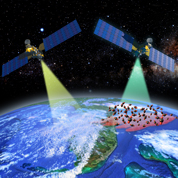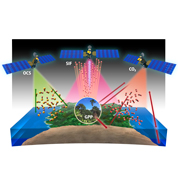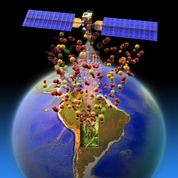Next-Generation Approach for Detecting Climate-Carbon Feedbacks: Space-Based Integration of Carbonyl Sulfide (OCS), CO2, and Solar Induced Fluorescence (SIF)
Workshop Image Gallery
The KISS images below are public domain, but must be accompanied by the appropriate image credit.
Satellite measurements of COS address a persistent challenge of cloud contamination. Clouds present challenges for satellite detection of regional photosynthesis that rely on the radiation emitted by ecosystems. However, an alternative approach leverages the chemical record of photosynthesis that is left in the atmosphere as carbonyl sulfide gas concentrations. When the clouds clear or the air mass is advected downstream of the clouds, the chemical record can be viewed by satellites.
Image credit: Keck Institute for Space Studies / Chuck Carter.
Schematic illustration of the natural sources and sinks for remote sensing of OCS, SIF, and CO2. The natural carbon cycle (red) is dominated by exchanges between terrestrial photosynthesis (GPP), ecosystem respiration (Re), and the surface and deep oceans. The dominant global OCS fluxes (green) are the plant sink and surface ocean source. SIF is directly emitted from leaves. These three signals provide highly complementary views into net ecosystem exchange (CO2) and controls on photosynthesis that are biophysical (OCS) and biogeochemical (SIF).
Image credit: Keck Institute for Space Studies / Chuck Carter.
The Amazon Hydrologic Basin can be thought of as light- or water-limited. The identification of the Amazon basin as an ideal domain where the temporally integrated OCS analysis could confront cloud contamination problems of alternative approaches (CO2 and SIF). For example, the satellite detection of a massive depletion in OCS over the Amazon can provide a measurement-based estimate of photosynthesis. Proof-of-concept studies including an airborne field experiment in the Amazon and an observing system simulation experiment will provide critical evidence for the proposed satellite observations.
Image credit: Keck Institute for Space Studies / Chuck Carter.




